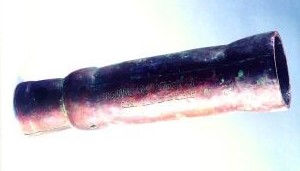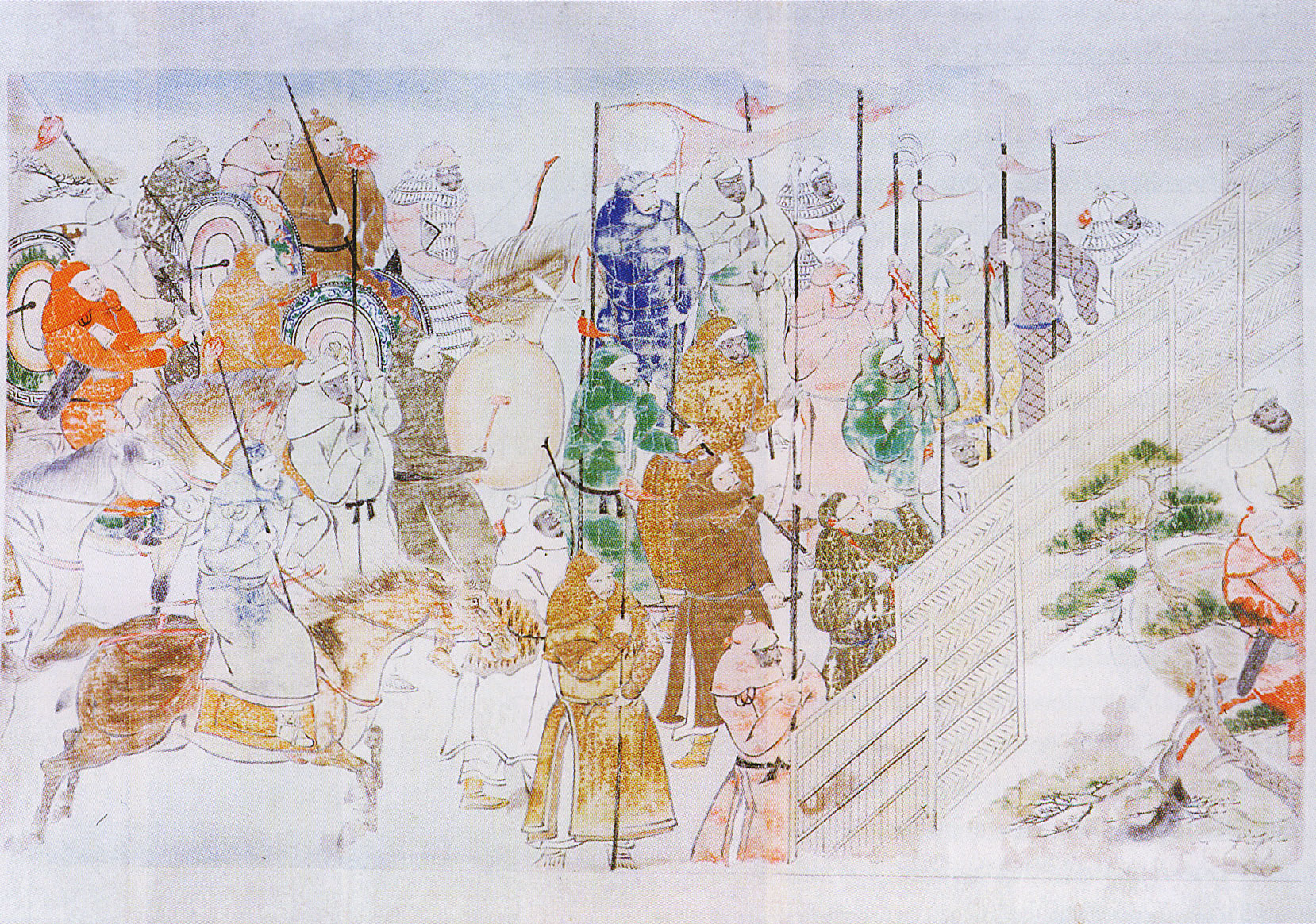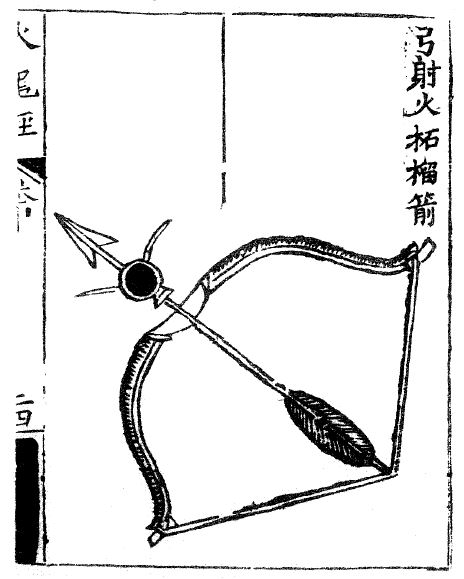|
Xanadu Gun
The oldest extant gun bearing a date of production is the Xanadu Gun, so called because it was discovered in the ruins of Xanadu (Shangdu), the summer palace of the Yuan dynasty in Inner Mongolia, China. The Xanadu Gun is 34.7 cm in length and weighs 6.21 kg, its muzzle is flared outwards, slightly bowl-shape, and called by Chinese as 碗口铳 ( Wǎn kǒu chòng). Its dating is based on archaeological context and a straightforward inscription containing an era name and year that correspond with the Gregorian Calendar at 1298. Not only does the inscription contain the era name and date, it also includes a serial number and manufacturing information which suggests that gun production had already become systematized, or at least become a somewhat standardized affair by the time of its fabrication. The design of the gun includes axial holes in its rear which some speculate could have been used in a mounting mechanism. Like most early guns with the possible exception of the ... [...More Info...] [...Related Items...] OR: [Wikipedia] [Google] [Baidu] |
Military Of The Yuan Dynasty
The military of the Yuan dynasty (1271–1368) were the armed forces of the Yuan dynasty, a fragment of the Mongol Empire created by Kublai Khan in China. The forces of the Yuan were based on the troops that were loyal to Kublai after the Division of the Mongol Empire in 1260. At first this ''Tamma'', a frontier army drawn from all Mongol tribes for conquest of China, had no central organisation but was rather a loose collection of local warlords and Mongol princely armies. However the army was gradually reformed by Kublai Khan into a more systematic force. Army Organisation Unlike previous Chinese dynasties that strictly separated military and civilian power, the Yuan administration of military and civil affairs tended to overlap, as a result of traditional Mongol favour for military matters. This was harshly criticised by the Chinese scholar officials at the time. Military officers were allowed to pass on their positions to their sons or grandsons after death, retirement or some ... [...More Info...] [...Related Items...] OR: [Wikipedia] [Google] [Baidu] |
Chinese Inventions
China has been the source of many innovations, scientific discoveries and inventions. This includes the '' Four Great Inventions'': papermaking, the compass, gunpowder, and printing (both woodblock and movable type). The list below contains these and other inventions in ancient and modern China attested by archaeological or historical evidence, excluding prehistoric inventions of Neolithic and early Bronze Age China. The historical region now known as China experienced a history involving mechanics, hydraulics and mathematics applied to horology, metallurgy, astronomy, agriculture, engineering, music theory, craftsmanship, naval architecture and warfare. Use of the plow during the Neolithic period Longshan culture (c. 3000–c. 2000 BC) allowed for high agricultural production yields and rise of Chinese civilization during the Shang Dynasty (c. 1600–c. 1050 BC). Later inventions such as the multiple-tube seed drill and the heavy moldboard iron plow enabled China to sus ... [...More Info...] [...Related Items...] OR: [Wikipedia] [Google] [Baidu] |
Artillery Of China
Artillery is a class of heavy military ranged weapons that launch munitions far beyond the range and power of infantry firearms. Early artillery development focused on the ability to breach defensive walls and fortifications during sieges, and led to heavy, fairly immobile siege engines. As technology improved, lighter, more mobile field artillery cannons developed for battlefield use. This development continues today; modern self-propelled artillery vehicles are highly mobile weapons of great versatility generally providing the largest share of an army's total firepower. Originally, the word "artillery" referred to any group of soldiers primarily armed with some form of manufactured weapon or armor. Since the introduction of gunpowder and cannon, "artillery" has largely meant cannons, and in contemporary usage, usually refers to shell-firing guns, howitzers, and mortars (collectively called ''barrel artillery'', ''cannon artillery'', ''gun artillery'', or - a layman term - ... [...More Info...] [...Related Items...] OR: [Wikipedia] [Google] [Baidu] |
Military History Of The Yuan Dynasty
A military, also known collectively as armed forces, is a heavily armed, highly organized force primarily intended for warfare. It is typically authorized and maintained by a sovereign state, with its members identifiable by their distinct military uniform. It may consist of one or more military branches such as an army, navy, air force, space force, marines, or coast guard. The main task of the military is usually defined as defence of the state and its interests against external armed threats. In broad usage, the terms ''armed forces'' and ''military'' are often treated as synonymous, although in technical usage a distinction is sometimes made in which a country's armed forces may include both its military and other paramilitary forces. There are various forms of irregular military forces, not belonging to a recognized state; though they share many attributes with regular military forces, they are less often referred to as simply ''military''. A nation's milit ... [...More Info...] [...Related Items...] OR: [Wikipedia] [Google] [Baidu] |
Weapons Of The Mongol Empire
A weapon, arm or armament is any implement or device that can be used to deter, threaten, inflict physical damage, harm, or kill. Weapons are used to increase the efficacy and efficiency of activities such as hunting, crime, law enforcement, self-defense, warfare, or suicide. In broader context, weapons may be construed to include anything used to gain a tactical, strategic, material or mental advantage over an adversary or enemy target. While ordinary objects – sticks, rocks, bottles, chairs, vehicles – can be used as weapons, many objects are expressly designed for the purpose; these range from simple implements such as clubs, axes and swords, to complicated modern firearms, tanks, intercontinental ballistic missiles, biological weapons, and cyberweapons. Something that has been re-purposed, converted, or enhanced to become a weapon of war is termed weaponized, such as a weaponized virus or weaponized laser. History The use of weapons is a major driver of cultural ... [...More Info...] [...Related Items...] OR: [Wikipedia] [Google] [Baidu] |
Hu Dun Pao
''Hu dun pao'' (虎蹲砲) is the name of two different missile weapons in Chinese history. In the Song dynasty (960–1279), it was a trebuchet and its name is translated into English as Crouching Tiger Trebuchet; in the Ming dynasty (1368–1644), the name was given to a type of bombard and it is known in English as Crouching Tiger Cannon. Trebuchet According to the Song dynasty military compendium ''Wujing Zongyao'' (published 1044), the ''hu dun pao'' is depicted as a traction trebuchet with a triangular frame. It is operated by a dedicated corps of 70 haulers, who took turns pulling the ropes attached to the trebutchet arm to send the projectile, a stone or bomb, into flight. It has a range of . The '' Annales ianuenses'', the official history of Genoa, carries drawings of ''trabuchium'', a counterweighted trebuchet with triangular supporting trusses, that Sinologist Joseph Needham considers to be derived from or related to the Chinese "Crouching Tiger Trebuchet". Similar tr ... [...More Info...] [...Related Items...] OR: [Wikipedia] [Google] [Baidu] |
Huo Chong
''Huochong'' () was the Chinese name for hand cannons. The oldest confirmed metal ''huochong'', also the first cannon, is a bronze hand cannon bearing an inscription dating it to 1298 (see Xanadu Gun, Xanadu gun). By the time of the Ming Dynasty (1368–1644) two types of ''huochong'' were in use. One was a hand held version with a wooden shaft known as a '' shouchong'' () whilst the larger ''Wankouchong'' ( — bowl-mouthed cannon) or ''Zhankouchong'' ( — cup-mouthed cannon) rested on a supporting wooden frame.'' History of Ming'' Army Records Chapter Four It was invented presumably as an advance in warfare, a new way to fight. Gallery File:上都火銃.jpg, The Xanadu gun, 1298, is an example of a Wankouchong () File:Bronze cannon of 1332.jpg, Bronze cannon with inscription dated the 3rd year of the Zhiyuan era (1332) of the Yuan Dynasty (1271–1368); it was discovered at the Yunju Temple of Fangshan District, Beijing in 1935. It is similar to Xanadu gun. File:M ... [...More Info...] [...Related Items...] OR: [Wikipedia] [Google] [Baidu] |
Heilongjiang Hand Cannon
The Heilongjiang hand cannon or hand-gun is a bronze hand cannon manufactured no later than 1288 and is the world's oldest confirmed surviving firearm. It weighs 3.55 kg (7.83 pounds) and is 34 centimeters (13.4 inches) long. The Heilongjiang hand cannon was excavated during the 1970s in Banlachengzi, a village in Acheng District, Heilongjiang province, China. It was found alongside other bronze artifacts made in the style of the Jurchen Jin Dynasty (12th–13th century). The hand cannon was probably used in battles fought nearby in Banlachengzi in 1287 and 1288. The ''History of Yuan'' states that a Jurchen commander by the name of Li Ting led a group of soldiers equipped with hand cannons into a military camp in 1288, as part of an anti-rebellion campaign for the Yuan dynasty. The cannon currently resides at the Heilongjiang Provincial Museum in Harbin, China. Description The Heilongjiang hand cannon is long without a handle and weighs . The diameter of the interior ... [...More Info...] [...Related Items...] OR: [Wikipedia] [Google] [Baidu] |
Gunpowder Weapons In The Song Dynasty
Gunpowder weapons in the Song dynasty included fire arrows, gunpowder lit flamethrowers, soft shell bombs, hard shell iron bombs, fire lances, and possibly early cannons known as "eruptors". The eruptors, such as the "multiple bullets magazine eruptors" (bǎi-zi lián zhū pào, 百子連珠炮), consisting of a tube of bronze or cast iron that was filled with about 100 lead balls,Needham, Volume 5, Part 7, 263-364. and the "flying-cloud thunderclap eruptor" (fēi yún pī-lì pào, 飛雲霹靂炮), were early cast-iron proto-cannons that did not include single shots that occluded the barrel (thus called "co-viative" weapons). The use of proto-cannon, and other gunpowder weapons, enabled the Song dynasty to ward off its generally militarily superior enemies—the Khitan led Liao, Tangut led Western Xia, and Jurchen led Jin—until its final collapse under the onslaught of the Mongol forces of Kublai Khan and his Yuan dynasty in the late 13th century. History Fire arrow ... [...More Info...] [...Related Items...] OR: [Wikipedia] [Google] [Baidu] |
Shangdu
Shangdu (, ), also known as Xanadu (; Mongolian: ''Šandu''), was the summer capital of the Yuan dynasty of China before Kublai decided to move his throne to the former Jin dynasty capital of Zhōngdū () which was renamed Khanbaliq (present-day Beijing). Shangdu is located in the present-day Zhenglan Banner, Inner Mongolia. In June 2012, it was made a World Heritage Site for its historical importance and for the unique blending of Mongolian and Chinese culture. Venetian traveller Marco Polo described Shangdu to Europeans after visiting it in 1275. It was conquered in 1369 by the Ming dynasty army under the Hongwu Emperor. In 1797, historical accounts of the city inspired the famous poem '' Kubla Khan'' by the English Romantic poet Samuel Taylor Coleridge. Descriptions Shangdu was located in what is now Shangdu Town, Zhenglan Banner, Inner Mongolia, north of Beijing. It is about northwest of the modern town of Duolun. The layout of the capital is roughly square ... [...More Info...] [...Related Items...] OR: [Wikipedia] [Google] [Baidu] |
Wuwei Bronze Cannon
The Wuwei Bronze Cannon (武威銅火炮 — Wǔwēi tóng huǒpào) or Xi Xia Bronze cannon (西夏铜火炮 — Xīxià tóng huǒpào)Kelly DeVries, John France, Clifford J. Rogers (October 2015). Journal of Medieval Military History'. 13: 251. was discovered in 1980 and is probably the oldest and largest cannon dated to the 13th century. This 100 centimeter long, 108 kilogram bronze cannon was discovered in a cellar in Wuwei, Gansu Province. It bears no inscription, but has been dated by historians to the late Western Xia period between 1214 and 1227 through contextual evidence. The gun contained an iron ball about nine centimeters in diameter, which is smaller than the muzzle diameter at twelve centimeters, and 0.1 kilograms of gunpowder in it when discovered, meaning that the projectile might have been another co-viative. Ben Sinvany and Dang Shoushan believe that the ball used to be much larger prior to its highly corroded state at the time of discovery. While large in siz ... [...More Info...] [...Related Items...] OR: [Wikipedia] [Google] [Baidu] |









